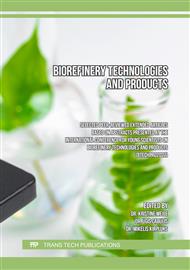p.139
p.147
p.155
p.162
p.169
p.179
p.185
p.193
p.200
Medium Formulation and Fed-Batch Cultivation of Methylosinus trichosporium
Abstract:
Methanotrophs display the ability to consume methane as a carbon source and produce a wide-range of high-value products, e.g. ectoine/hydroxyectoine, poly-b-hydroxybutyrate (PHB), single cell protein, extracellular polysaccharides and lipids. Usually methanotrophs show low specific substrate consumption rates, which restricts their application at pilot and industrial scale. Thus, in order to reduce the time and costs of the cultivation process, it is vital to accelerate the growth of applied organisms. Usually, methanotrophic bacteria cultivations are carried out using fully synthetic mineral mediums (nitrate mineral salts medium (NMS)) without the addition of any growth factors. Potentially, higher biomass growth and substrate uptake rates can be achieved by supplementing the growth medium with vitamins, amino acids etc. or by using more bioavailable substrates.The aim of our research was to study the influence of growth factors such as vitamins, and different nitrogen sources (yeast extract, yeast nitrogen base with/without amino acids and tryptone) on the growth of Methylomonas methanica, Methylomicrobium alcaliphilum and Methylosinus trishosporium.Experiments for studying the influence of growth factors were carried out in shake flasks by varying the medium compositions and analyzing the effects of said variations on the kinetics of the cultivation, e.g. specific biomass growth rate and biomass yield from substrate.Subsequent tests of the developed nutrient medium, which promotes higher biomass growth rates, were carried out in laboratory 5 L bioreactor Methylosinus trishosporium cultivations to study the main process parameters.From the statistical analysis of experimental data it was observed, that supplementation of the growth medium with yeast extract or tryptone, seems to promote the growth rate of methanotrophs, when methanol is used as the main substrate. Furthermore, specific growth rates observed during cultivations in mediums containing vitamins (including cobolamin) also seem to positively affect the biomass growth rate. Based on the results of lab-scale bioreactor cultivations, using the identified medium composition it was possible to achieve a maximal biomass specific growth rate of 0.15 L⸱h‑1 and productivity of 0.16 g⸱L-1⸱h-1.
Info:
Periodical:
Pages:
179-184
Citation:
Online since:
October 2022
Keywords:
Price:
Сopyright:
© 2022 Trans Tech Publications Ltd. All Rights Reserved
Share:
Citation:



